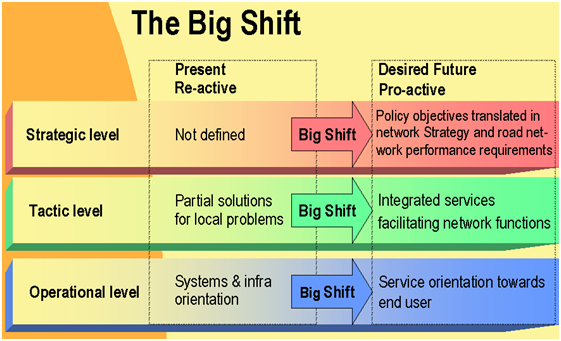
Road Network Operations
& Intelligent Transport Systems
A guide for practitioners!

Road Network Operations
& Intelligent Transport Systems
A guide for practitioners!
To meet the expectations of road users and the demands of a society needing to move rapidly and securely, road authorities and the various actors in charge of road networks have to do their best to provide the level of service expected by the end users.
In the past, this level of service mainly depended on the provision of a suitable and comfortable roadway infrastructure, thereby ensuring a safe and relatively quick journey between an origin and a destination.
Today, with rapid traffic growth leading to congestion, there are new expectations like:
This evolution is captured in the notion of a “big shift” affecting the management and operation of roads. Two developments have been highly relevant for road network operations :
Together these shifts are referred to as a “big shift” because they both refer to the change of emphasis from road construction and maintenance to road network operations, which is a much wider spectrum.

For many road administration this evolution amounts to a revolution, in the sense that the road user is more than a user, but increasingly a client: whether or not he/she pays directly to use the road, expectations are similar in terms of level of service, guarantee of travel time, information on disruptions, and so on. This is especially so for professional road users.
The challenge for the managers of the transportation system is significant. They must alter their thinking in operating a complex system to include the customer/user as the focal point. Many constraints and challenges are revealed with a Network Operations focus as related to:
All categories of stakeholders are concerned, among them:
It is not a simple task to appreciate the various perspectives of different road user groups. Nor is it easy to balance the criteria that are set by the different categories of user. Depending on their position and interest, user needs can be distinguished from a point of view of:
Understanding the perspective of the road user is of utmost importance. This starts with formulating desired services in his or her terms, such as “support for a safe and stress-free journey” rather than “traffic management”. It then becomes essential to realise that delivering these services and the measurement of the quality of the services is not an easy task as it is dependent on users’ perception and appreciation, which by its nature is not very stable.
It is useful to remember that:
With a customer satisfaction mindset comes the need to incorporate a performance focus into existing processes, to establish performance measures focused on outcomes (as opposed to outputs), and to track performance against those measures. The assessment of the network’s performance must further be used to actually improve operations both in the short term and long term.
Increasingly, road network operations will require defined levels of service and associated quality indicators that reflect user satisfaction and the efficiency of the road network when considered as part of an integrated transport system.
The implications of prioritising the needs of road users can be considered at three levels, strategic, tactical and operational:
Strategic: this is the level where social and transport policy objectives are translated into road network performance requirements in qualitative terms of traffic flow, traffic safety and convenience. (See Strategic Planning)
National Road Authorities have, in general, unambiguous policy goals concerning traffic safety, traffic flow, economic prosperity and sustainability. Many strategic level goals are internationally recognised yet these goals are not explicitly translated into road network performance requirements. Formulating recommendations on how to do this is the first challenge of the strategic level.
Tactical: this is the level where network performance requirements are translated into network functions to a certain level of service or quality offered to the road user. Furthermore, “services” are defined on this level, which indicate the network functionality to be performed at a certain standard. Decisions at the strategic level generally have long term implications, tactics are determined in the medium to short term. (See Planning and Reporting)
On the tactical level measures are often implemented to solve local problems, isolated from a more global framework. For example it is now common that ITS are implemented to solve local traffic problems. However, we should aim for a situation where the measures (such as VMS) will serve strategic as well as local requirements. The challenge of the tactical level is to take these constraints into account and to integrate the ITS services across the road network as a whole.
Operational: this level confronts the organisational requirements, procedures and protocols, with the implementation of tools and strategies in order to meet users’ needs. The operational level is the most dynamic often changing on a day-to-day basis. (See Operational Activities)
On the operational level the present practice is commonly one of systems and equipment orientation. But technical solutions can be also be presented through services to road users. This notion indicates that services are made up of systems installed in organisations trained to operate the systems effectively. These organisations are driven by policy objectives. To meet policy objectives the attitude and behaviour of the road user is often critical. Therefore when ITS and other measures are deployed it should be customer oriented: oriented towards the road user. Hence, a service orientation is desirable rather than a systems orientation. The same occurs with more conventional tasks such as the organisation of road-works, such as the design of signing, or emergency call-outs
In many cases operating procedures and protocols have to be reviewed and adapted in the context of service to the user. This is the major challenge for network operations at the operational level.